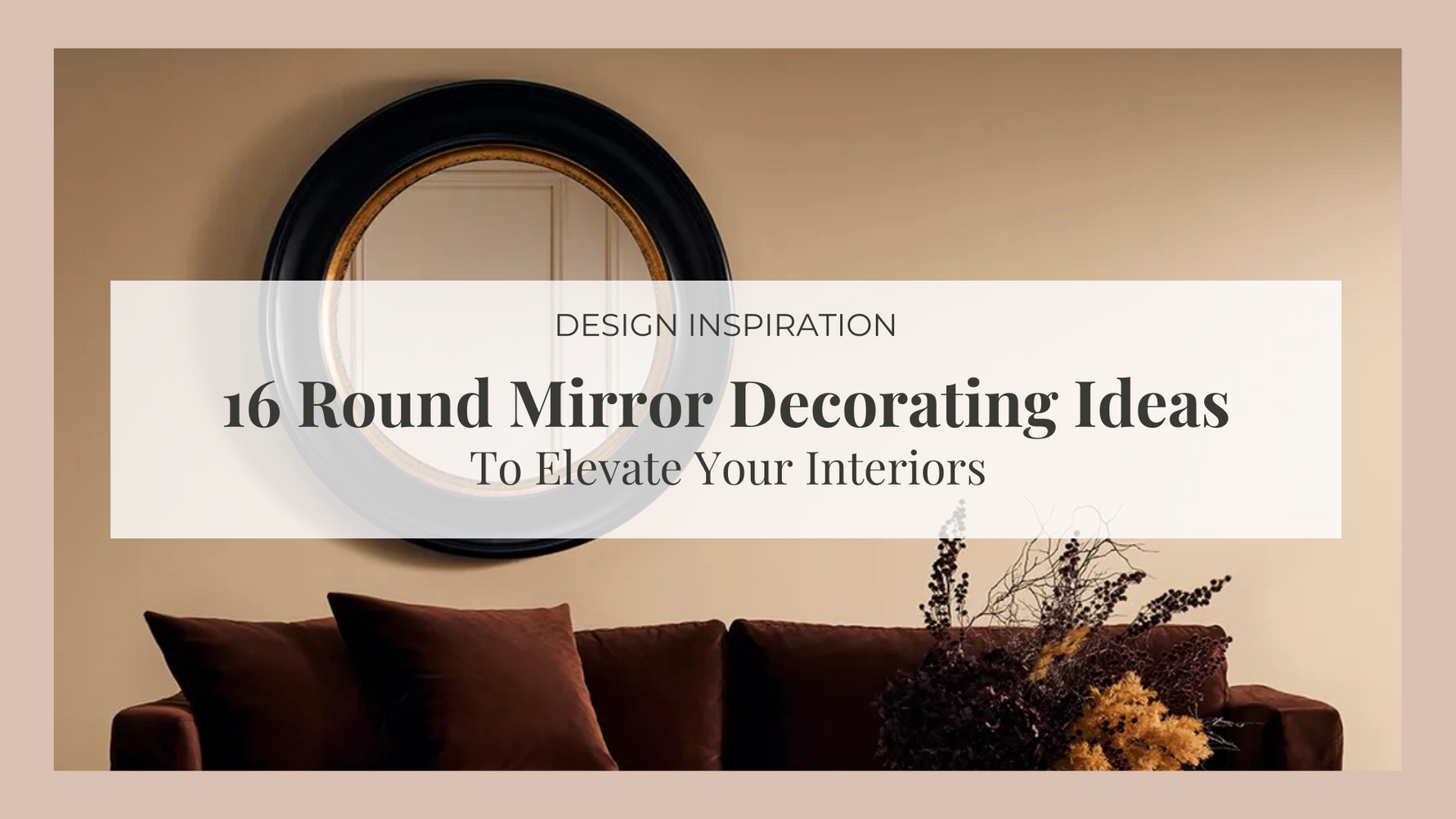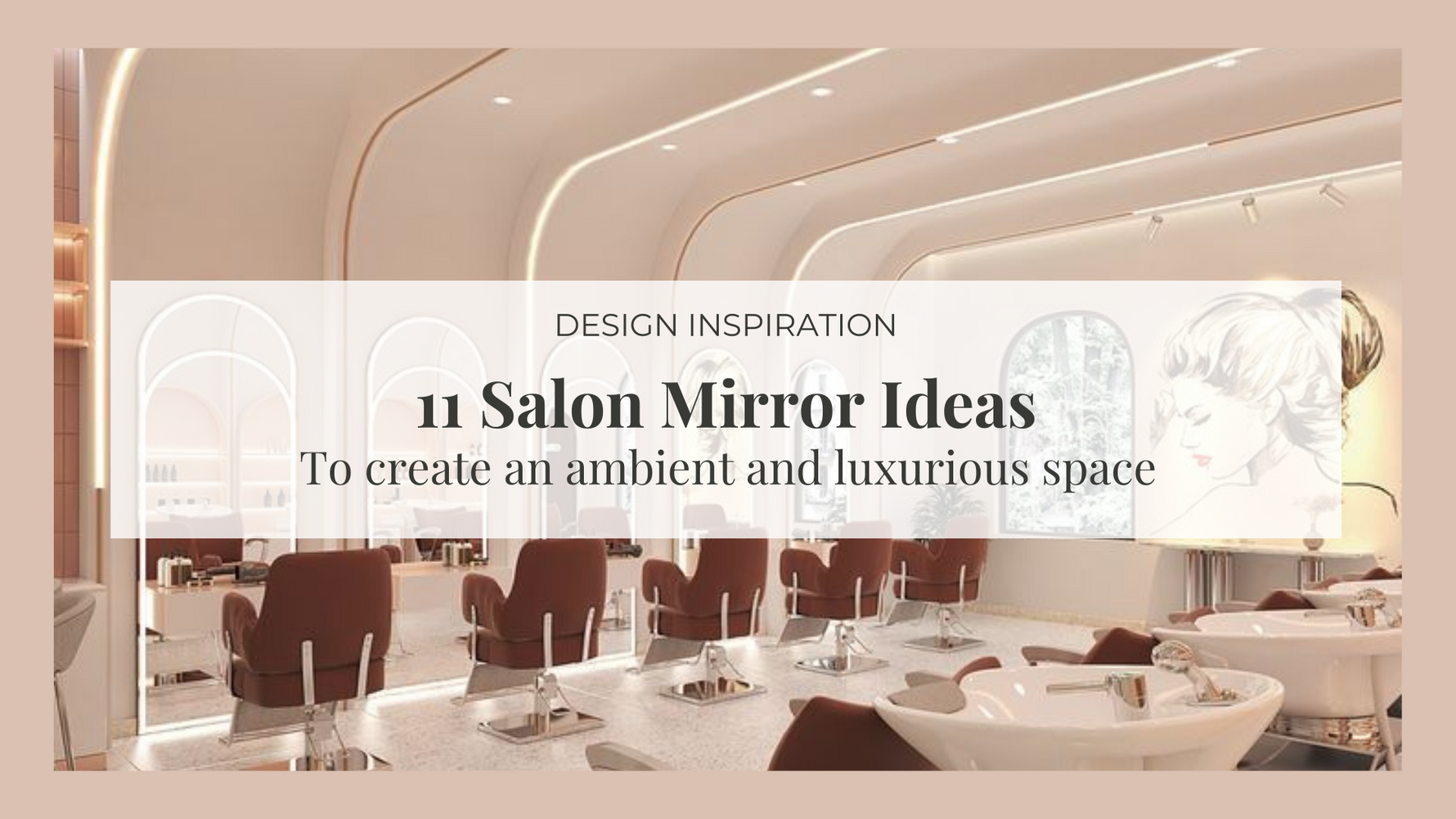
How to Choose the Best Mirror for Your Bathroom – 9 Considerations
Choosing the best mirror for your bathroom is an essential part of creating a functional and stylish space. A well-chosen bathroom mirror can enhance your bathroom’s aesthetic appeal, improve functionality, and even make the space feel larger. In this blog post, we’ll guide you through the top 9 considerations to keep in mind when selecting the best bathroom mirror for your space.
Considerations:
- Mirror Size
- Mirror Shape
- Material
- Style: Framed vs Frameless
- Mounting Options
- LED Mirror vs Normal Bathroom Mirror
- Bathroom Mirror vs Bathroom Cabinet
- Safety and Quality Standards
- Price
- FAQs
1. Mirror Size
When choosing a bathroom mirror, it's important to consider both the size of your vanity and the overall bathroom layout. A mirror should generally be smaller in width than your vanity to maintain balance and visual harmony. For example, if your vanity is 120 cm wide, a mirror that is 90–110 cm wide would be ideal.
Tips for Choosing Right the Bathroom Mirror Size:
- Measure the width of your vanity or sink area.
- Consider the ceiling height to ensure the mirror isn’t too tall or too short.
- In smaller bathrooms, choosing a larger mirror can create a sense of depth and openness.
Checkout our guide here on some mirror design ideas for small bathrooms.
2. Mirror Shape
Bathroom mirrors come in various shapes, each contributing a unique style to the space. While rectangular and square mirrors, with their clean and streamlined profiles, have traditionally been popular for modern and contemporary interiors, 2024 has seen a shift towards round and curved mirrors. These shapes soften the sharp, angular lines of the bathroom, contributing to a more relaxed and calming atmosphere.

Product: Lumixe Nexus Rectangular LED Bathroom Mirror
Rectangular and square mirrors are a classic and versatile option that suits both traditional and contemporary styles. They provide a wider reflection, making them ideal for longer vanities with double sinks, as they create a seamless connection between the two basins, adding a sense of unity.

Product: Remer Gatsby LED Mirror Matte Black
A softer alternative to rectangular mirrors, round and oval mirrors bring a smooth, continuous form that complements organic or modern designs. Perfect for vanities with a single bowl or for double vanities where two mirrors are needed. The elongated shape of oval mirrors help to create the illusion of added height in the space.

Product: Ablaze Arch Juno Bathroom Mirror
Arch bathroom mirrors have a rounded top, lending an elegant, vintage feel to the bathroom. They work well in traditional or art deco-inspired spaces.

Product: Belbagno Triangolo LED Bathroom Mirror
There is also a growing trend towards unconventional mirror shapes in the bathroom. Organic-shaped bathroom mirrors, with their fluid and freeform edges, are perfect for adding a bold, artistic flair to a modern or creatively designed space. These mirrors create visual interest by breaking away from standard geometric forms, making them ideal for homeowners who want to inject personality into their bathroom décor.

Product: Ablaze D-shaped Bathroom Mirror
D-shaped bathroom mirrors, which feature a flat bottom edge combined with a curved top, offer a sleek and contemporary option. These mirrors work particularly well in small bathrooms, as their compact yet stylish design provides a modern aesthetic without overwhelming the space. Their versatile shape allows them to complement minimalist designs or add a contemporary edge to more traditional spaces.

Product: Lumixe ALBA LED Bathroom Mirror
For bathrooms with limited wall space, corner mirrors are an excellent solution. Designed to fit snugly into the corner of the room, these mirrors help to maximise space while providing essential functionality. Perfect for smaller bathrooms or ensuites, corner mirrors are a practical yet stylish choice that helps make the most of every inch of available room.
3. Material
When selecting a bathroom mirror, ensuring durability and resistance to rust and corrosion is crucial. The quality of materials used in the construction of your mirror is essential for long-term performance, especially in a moisture-prone environment like a bathroom.
Firstly, look for mirrors with copper-free glass. This type of glass is designed to resist corrosion that can occur beneath the surface, extending the life of your mirror and maintaining its clarity and appearance.
Secondly, pay close attention to the frame material. A high-quality frame should be treated to resist moisture and prevent water damage. For wooden frames, ensure they are properly sealed to protect against the bathroom’s humid conditions. Metal frames should be coated or finished to guard against rust and deterioration. Chrome, aluminium and stainless-steel frames are commonly used due to their water resistance and durability.
Finally, the backing material is as important as the glass and frame. Mirrors with moisture-resistant backings help to prevent mould, mildew, and warping in humid environments. High-grade options like silvered or acrylic backings are ideal, with anti-rust coatings providing additional protection. Additionally, ensure that the adhesive used for securing the backing for glue-to-wall mirrors is also water-resistant.
By choosing mirrors with these considerations in mind, you ensure that your investment will stand up to the rigours of a bathroom environment, maintaining both its function and aesthetics over time.
4. Style: Framed vs Frameless
When choosing a bathroom mirror, it’s essential to consider how it will complement your overall design while providing practical benefits. Both frameless and framed mirrors have their unique advantages and potential drawbacks, making them suitable for different styles and needs.

Product: Ablaze Duke Oval Frameless Bathroom Mirror
Frameless mirrors offer a sleek, modern aesthetic with their clean lines and minimalistic design. They are particularly well-suited for contemporary spaces where simplicity and elegance are key. They are also more cost effective!
Pros:
- Streamlined Aesthetic: Frameless mirrors create a seamless look that enhances modern and minimalist bathrooms, contributing to a spacious, uncluttered appearance.
- Easy Maintenance: Without a frame, there are no crevices where dust and grime can accumulate, making them easier to clean. Additionally, frameless mirrors are less prone to issues like corrosion that can affect frames.
- Versatility: Frameless mirrors can be mounted in various orientations—horizontally or vertically—allowing flexibility in design and installation.
Cons:
- Limited Edge Protection: The absence of a frame means that the edges of frameless mirrors are exposed and can be more prone to chipping or breaking. Extra care is required during installation and use.

Product: Ablaze Georgia Round Mirror with Black Frame
Framed bathroom mirrors can let your style shine through with the variety of framing options available. They are available in a range of materials and finishes that can enhance traditional, contemporary or vintage-inspired interiors.
Pros:
- Wide Range of Styles: Framed mirrors are available in numerous materials, styles and colour finishes, such as brushed brass, brushed nickel, and matte black. This variety allows you to match the mirror with your bathroom's decor and vanity.
- Enhanced Edge Protection: The frame adds durability and protection to the edges of the mirror, reducing the risk of breakage and making the mirror more robust.
Cons:
- Moisture Sensitivity: Frames made of wood or certain metals may be susceptible to moisture and humidity, which can lead to warping, rust, or other damage. It is crucial to choose framed mirrors specifically designed for bathroom use to avoid these issues.
5. Mounting Options
When choosing a mounting method for your bathroom mirror, it's essential to consider factors like ease of installation, durability, and the potential impact on your bathroom walls. Consider the weight and size of your mirror, the wall material, and how permanent you want the installation to be when making your choice. Make sure the mirror does not overlap with power outlets, countertop trims or other fixtures!

Product: Remer Modern Soft Rectangle Gun Metal
Wall-Mounted Mirrors: Wall-mounted mirrors are secured directly to the wall using screws and anchors. Make sure you purchase the appropriate screws and plugs for your wall type. This is the most traditional and stable method of mounting mirrors.
Pros:
- Stability: Provides a secure, long-lasting hold.
- Weight Capacity: Can support heavier mirrors and those with built-in lighting or storage.
- Aesthetic Flexibility: Allows for precise positioning and alignment.
Cons:
- Installation Effort: Requires drilling into the wall, which may not be suitable for all wall types (e.g., tiles).
- Permanent Fixture: Less flexibility if you wish to change the mirror’s location.

Product: Ablaze Rio Frameless Round Bathroom Mirror
Glue-to-Wall: Frameless mirrors use mirror adhesive to attach directly to the wall. This option is ideal for a clean, modern look without visible hardware.
Pros:
- Easy Installation: Simple to install with minimal tools required.
- No Wall Damage: Does not involve drilling, making it suitable for delicate surfaces.
- Modern Look: Provides a sleek, frameless appearance.
Cons:
- Limited Weight Capacity: Suitable mainly for lighter mirrors.
- Durability: Adhesives may weaken over time or in high-humidity environments.
Stick-On Mirrors: Stick-on mirrors use adhesive backing to attach directly to the wall, similar to wall-mounted mirrors with adhesive but typically in a peel-and-stick format.
Pros:
- Simple Installation: Quick and easy to install with a peel-and-stick application.
- No Damage: Ideal for renters or temporary setups, as it doesn’t damage walls.
- Variety: Available in various shapes and sizes, including decorative options.
Cons:
- Adhesive Quality: May not be as durable as other methods, with potential for peeling over time.
- Limited Weight Capacity: Suitable mainly for lightweight mirrors.
- Surface Suitability: Adhesive may not adhere well to all surfaces or in high-humidity areas.
6. LED Mirror vs Normal Mirror
When choosing between a LED mirror and a traditional mirror, it’s essential to consider your specific needs, style preferences, and budget. LED mirrors are known for their advanced features and sleek modern look. Their integrated lighting provides even, shadow-free illumination, making them perfect for grooming tasks like shaving or applying makeup. Some LED mirrors have a sandblasted border which helps to diffuse the LED light around the edges, creating a softer, more even illumination. On the other hand, traditional mirrors are more straightforward and cost-effective, making them a practical option for those seeking a classic appearance without the need for integrated lighting.

Product: Lumixe ASTA LED Bathroom Mirror
Below is a few of the advanced functionalities that LED Mirrors offer:
- Adjustable Lighting: Many LED mirrors come with dimmable features or multiple light settings (e.g., cool, warm, and natural light) that allow users to adjust the brightness and colour temperature according to their preferences and needs.
- Anti-Fog Technology: LED mirrors often include an anti-fog feature, which uses a built-in heating element to prevent the mirror from fogging up during or after a hot shower. This ensures a clear reflection at all times.
- Touch Controls: Advanced LED mirrors feature touch-sensitive controls that allow users to adjust the lighting, activate anti-fog functions, and even switch between different lighting modes with a simple touch.
- Built-In Bluetooth Speakers: Some LED mirrors come with integrated Bluetooth speakers, enabling users to listen to music, take phone calls, or enjoy other audio entertainment while in the bathroom.
- Smart Features: Modern LED mirrors may include smart capabilities such as built-in clocks, temperature displays, or even voice control, enhancing convenience and functionality.
- Magnification Options: Certain LED mirrors feature built-in magnification sections, ideal for close-up tasks like grooming or makeup application. These sections can be integrated into the main mirror or as a detachable component.
Click here to read how to choose the perfect LED mirror for your bathroom
8. Bathroom Mirror vs Bathroom Mirror Cabinet
Want to declutter your bathroom space? A bathroom mirror cabinet might just be the solution for you. They combine a mirror with built-in storage, offering practical benefits for those seeking to organise toiletries, medications, and other bathroom essentials. Furthermore, they sometimes include integrated LED lighting for added visibility and create a beautiful ambiance in the bathroom. While mirror cabinets offer valuable storage solutions and additional functionalities, they usually come at a higher price and require more complex installation compared to standard mirrors.

Product: Oblong White Mirror Cabinet
Fully-recessable vs Semi-recessable
A fully recessable bathroom cabinet is installed within the wall cavity, with the mirror surface flush against the wall, creating a sleek, integrated appearance. Since the cabinet body is hidden behind the wall, only the mirror remains visible, offering a minimalist aesthetic. However, installation can be complex, as it often requires modifications to the wall, such as cutting and reinforcing the cavity to ensure proper support. This process typically calls for professional installation. Additionally, not all bathrooms can accommodate this design due to structural limitations, such as insufficient wall depth or hidden pipes and wiring.
A semi-recessable bathroom cabinet is partially built into the wall, with the cabinet body extending slightly outward while the mirror remains flush. This design allows for deeper storage compartments compared to fully recessable cabinets, as part of the cabinet extends into the room. However, the protruding design takes up some of the available bathroom space, which may not be ideal for very small bathrooms. Additionally, the more pronounced profile may not suit all aesthetic preferences, especially in bathrooms aiming for a fully modern, flush look.
9. Safety and Quality Standards
Ensuring your bathroom mirror meets Australian safety standards is crucial for peace of mind and long-lasting quality. Here are some important standards to consider:
- Waterproofing Standards (AS 3740): This standard ensures that mirrors, especially those in wet areas, are adequately waterproofed, protecting them from moisture damage and ensuring their longevity in humid environments like bathrooms.
- IP Rating (Ingress Protection Rating): Bathroom mirrors with electrical components, such as LED lights or anti-fog features, should have an appropriate IP rating (e.g., IP44 or higher) to ensure they are safe in damp environments.
- Electrical Safety Standards (AS/NZS 3000): Mirrors with built-in lighting or heating elements must adhere to this standard to ensure electrical safety in bathroom settings.
- Energy Efficiency Ratings: For LED mirrors, ensure they meet energy efficiency standards to save on electricity and reduce your environmental impact.
- Warranty: Look for mirrors with warranties to protect against manufacturing defects and ensure durability. It is important that you inspect the mirror thoroughly before installation, as installing faulty or damaged mirrors can void the warranty.
10. Price
Finally, it's essential to consider your budget when selecting a bathroom mirror. Setting a budget involves more than just considering the initial purchase price; it requires evaluating the cost of installation and long-term value. Investing in a higher-quality mirror or cabinet may have a higher initial cost but can offer better longevity and performance, potentially saving money on replacements and repairs in the long run. Balancing these factors will help ensure you select a mirror or mirror cabinet that meets your aesthetic and functional needs while staying within your financial parameters.
| Cost | Traditional Bathroom Mirror | LED Mirror | Mirrored Cabinet |
| Initial Cost | Generally the lowest cost option. Prices vary based on size, shape, and frame material. |
Higher than traditional mirrors due to integrated lighting. Costs increase with additional features like dimming and smart controls. |
Usually the most expensive due to dual functionality. Costs increase with premium materials and added features like built-in lighting. |
| Installation |
Typically straightforward. Can be installed DIY for standard sizes. Larger or heavy mirrors may require professional installation. |
Installation may be more complex. Requires electrical wiring for LED lighting. May need professional installation for advanced features. |
More complex installation. Often requires professional help for secure mounting and integration. Installation may include adjustments to wall structures or electrical work. |
| Ongoing Investment |
Low maintenance costs. Regular cleaning required. No additional operational costs. |
Higher maintenance for LED features. Requires regular cleaning to maintain effectiveness. Energy-efficient, leading to lower energy bills. May involve repairs for electronic components over time. |
Requires regular cleaning and maintenance of both the mirror and storage components. Potential additional costs for repairs or adjustments. No energy costs unless the cabinet includes integrated lighting. |
Conclusion
Choosing the best bathroom mirror requires balancing style, functionality, and practicality. Consider the mirror's size and shape to fit your space, and decide between frameless and framed options based on your aesthetic preferences. Evaluate materials for durability, and weigh the benefits of LED mirrors for energy efficiency and added features. Don’t overlook safety standards and the potential need for professional installation. By aligning your choice with your budget and long-term needs, you’ll find a mirror that not only complements your bathroom’s design but also offers lasting value and performance.
At Mirror Space, we work with a range of reputable Australian brands to offer you a wide selection of top quality bathroom mirrors, LED mirrors and mirrored cabinets. Browse the collection today and find your perfect bathroom mirror for your space.
Frequently Asked Questions
-
What is the ideal size for a bathroom mirror?
The ideal size for a bathroom mirror is typically slightly smaller in width than the vanity to ensure proportion and balance. As a general guideline, aim for your bathroom mirror to have about 1-2 inches of space on either side of the vanity. -
Can I put any mirror in my bathroom?
Not all mirrors are suitable for bathrooms. Ensure that the mirror is designed to withstand the moisture and humidity of a bathroom environment. Mirrors with anti-corrosion treatments or those specifically labeled for bathroom use are ideal. -
How to install a mirror without drilling?
Typically an option available for frameless or stick-on bathroom mirrors only. To install a mirror without drilling, you can use adhesive glue, adhesive hooks or mirror adhesive strips designed for wall mounting. Make sure the wall surface is clean and dry before applying these products for a secure hold. Always check the mirror's installation manual to identify how the mirror is meant to be mounted. -
Do bathroom mirrors have to be centered over the sink?
While it’s not a strict requirement, centering the mirror over the sink is often recommended for symmetry and practical use. It provides a balanced appearance and ensures ease of use. -
Do bathroom mirrors need to be tempered glass?
While tempered glass is not mandatory for all bathroom mirrors, it is highly recommended due to its safety features. Tempered glass is more resistant to breaking and, if it does break, it shatters into small, less harmful pieces. -
Can you visually tell the difference between glass and tempered glass?
Visually, it is difficult to distinguish between regular glass and tempered glass as they look similar. However, tempered glass is treated to be stronger and more resistant to thermal stress and impact. -
How much is tempered glass compared to regular glass?
Tempered glass is generally more expensive than regular glass due to its additional safety features and the manufacturing process. The cost difference reflects its enhanced durability and resistance to impact and thermal stress. -
What is the rule of thumb for hanging bathroom mirrors?
A good rule of thumb for hanging bathroom mirrors is to place the mirror so that the center is approximately eye level when standing, usually about 5-6 feet from the floor. Ensure it is well-proportioned to the space and vanity. -
Can you stick a bathroom mirror to tiles?
Yes, you can stick a bathroom mirror to tiles using adhesive designed for tile surfaces. Ensure the tiles are clean and dry before applying the adhesive for the best results. -
Do LED mirrors require professional installation?
For safety and to ensure proper functionality, it is recommended that LED mirrors be installed by a professional electrician. This is especially important if the mirror has integrated lighting and requires electrical connections. -
How do I clean bathroom mirrors?
To clean bathroom mirrors, use a soft, damp cloth to gently wipe the surface. Avoid harsh chemicals or abrasive materials that could damage the mirror’s surface or, in the case of LED mirrors, its electrical components. -
How can I prevent my bathroom mirror from fogging up?
To prevent fogging, consider using an anti-fog mirror or one with a built-in demister feature. These options are designed to keep the mirror clear even in humid environments.













